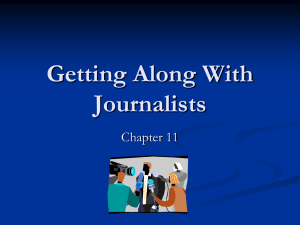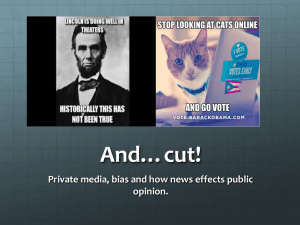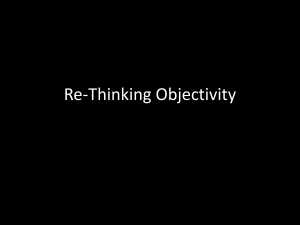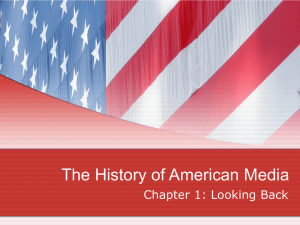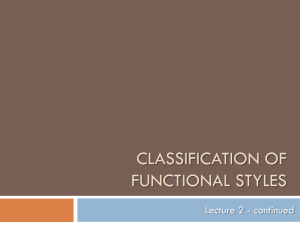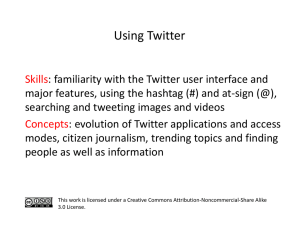PPTX - International Symposium on Online Journalism
advertisement
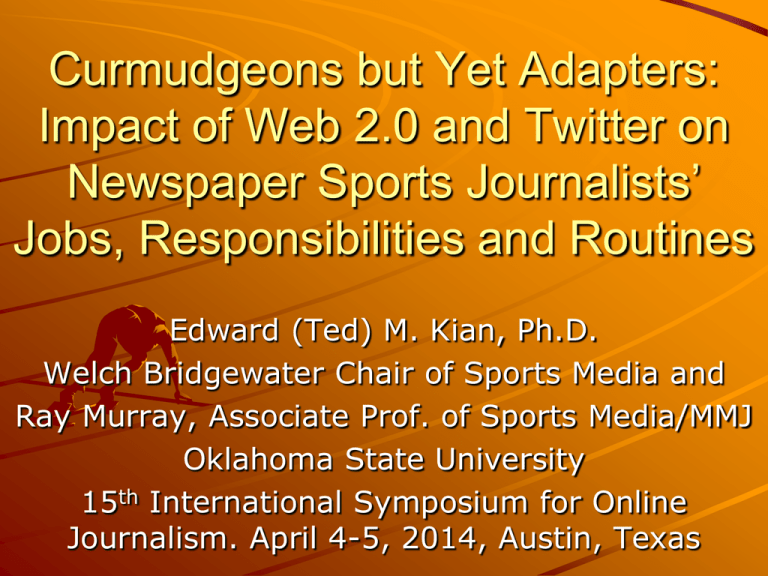
Curmudgeons but Yet Adapters: Impact of Web 2.0 and Twitter on Newspaper Sports Journalists’ Jobs, Responsibilities and Routines Edward (Ted) M. Kian, Ph.D. Welch Bridgewater Chair of Sports Media and Ray Murray, Associate Prof. of Sports Media/MMJ Oklahoma State University 15th International Symposium for Online Journalism. April 4-5, 2014, Austin, Texas Demise of U.S. Newspapers For more than two centuries, newspapers were the dominant news source in the world, with most U.S. newspapers dedicating a portion of their content exclusively to sports (Wanta, 2006). However, corporate consolidation coupled with drastic drops in circulation totals and advertising revenue left many U.S. reporters unemployed, with newspapers hit hardest (McChesney & Nichols, 2011). Accordingly, many top newspaper sports reporters took jobs with online sites (Kian & Hardin, 2009). The Advent of New Media Internet played a large part in the decline of traditional newspapers. New media are changing the way sport news is gathered, distributed, accessed, and consumed (Hutchins & Rowe, 2009). Readers can now be active– message boards, comments sections, etc. (Schultz & Sheffer, 2010). Internet readers tend to be younger than other media consumers, whereas newspaper readers are the oldest for all major mediums (Pew Research, 2013). Web 2.0 And Newspaper Sports Reporters Web 2.0 is a term used to describe the development of the WWW from standalone screens with limited features to more interconnected, interactive, and accessible networks (Butler et al., 2013). Sherwood & Nicholson (2012) exploratory study on Australian newspaper sportswriters’ showed Web 2.0 platforms had greatly affected their jobs, with Twitter having the greatest impact. Twitter and Old-School Sport Media Debuting in 2006, Twitter has over 645 million users worldwide. Although sports account for only 1.2% of all U.S. TV programming, 49.7% of all (global) tweets are sports-related (Nielsen, 2014). Exploratory surveys showed most sports reporters use Twitter as a means to gather and share information, with younger journalists using it more often and as a means of self-promotion (Schultz & Sheffer, 2010; Sherwood & Nicholson, 2013). Emergence of Convergence Web 2.0 has also resulted in increased sports media convergence, which (in this sense) refers to news content delivered through multiple mediums by the same reporter and/or news organization (Boyle & Whannel, 2010; Kian & Zimmerman, 2012). Newspaper editors now want sports reporters with skills beyond just writing; e.g., blogging, broadcast, marketing/PR, production, social media, etc. (Moore, 2010, Murray et al., 2009; Reed & Hansen, 2013). Purpose and Rationale Although a couple of surveys have partially broached these topics, little is known about traditional sport journalists’ experiences and attitudes on the advent of Web 2.0 and Twitter on their jobs and profession. This exploratory phenomenology examines the experiences and attitudes of veteran newspaper sports writers on the impact of the Internet, social media, and Twitter (i.e., Web 2.0) on their jobs and work routines/responsibilities. Research Questions Four broad, overriding research questions guided this exploratory phenomenology: RQ1: How has the advent of Web 2.0 impacted the job duties and work routines of these newspaper sports reporters? RQ2: How has the advent of Web 2.0 impacted the newspaper sports journalism profession? RQ3: What Web 2.0 platforms do these journalists use as part of their jobs? RQ4: What experiences have these journalists had with Twitter as part of their jobs? Data Collection and Analysis Purposeful sampling: Industry contacts used to contact experienced, FT newspaper sportswriters. Authors’ prior relationships? Loose interview guide was designed based on previous guides from research entailing interviews with sport media (Hardin & Shain, 2005; Kian, 2007; Kian & Zimmerman, 2012). Interviews were taped, transcribed, and coded individually by researchers in search for dominant themes (Glasser & Strauss, 1967). Sample Overall the 12 participants included 11 men and one woman. This is similar to the gender disparity in newspaper sports departments, where men comprise 90.4% of editors, 90.2% of columnists, and 88.3% of reporters (Lapchick, 2013). Similar global numbers (Bruce, 2013). Subjects’ ages ranged from 31-64; each had at least seven years of full-time experience in sport media and had worked for at least two newspapers in their careers; collectively they were employed in six U.S. states, although they had worked in 17 total states and at 23 different newspapers. Results Five dominant themes emerged from our data analysis: (1) The speed of Web 2.0 has changed reporters’ jobs for better and worse. (2) All journalists use Twitter for work, but most do not like interacting on Twitter. (3) Web 2.0 hurts newspaper industry sales, but gives reporters individual power. (4) You must now be a multimedia reporter. (5) Bloggers are not journalists, but they still hurt credibility of the profession. Discussion Journalists noted multiple ways that Web 2.0 and Twitter made them better reporters, especially in the news-gathering process. However, most also said the rise of Twitter hurt the overall quality of sports reporting due to the desire of disseminating info first. Whereas these reporters attributed many newspaper job losses to the rise of the Internet, they noted Web 2.0 had enabled them to reach larger and wider audiences. Limitations/Delimitations This research only interviewed 12 U.S. newspaper sports writers. Good mix of subjects, but purposeful sampling. All subjects were full-time, veterans of the newspaper industry, a field increasingly comprised of more part-time or freelance, and younger reporters. All of these reporters write for their newspapers’ print and online editions.
